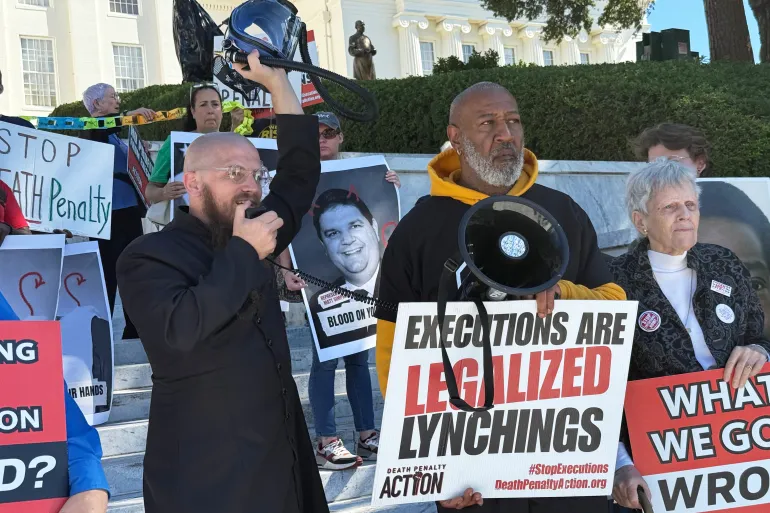
Montgomery, Alabama — The U.S. state of Alabama has executed Anthony Boyd, a 54-year-old man convicted of a 1993 murder, using nitrogen gas, a controversial method that human rights advocates have condemned as a “cruel and unusual form of punishment.”
Boyd was pronounced dead at 6:33 p.m. local time on Thursday after the state turned on the flow of nitrogen gas inside the execution chamber at the William C. Holman Correctional Facility. His execution marks the seventh time Alabama has used nitrogen gas since it first introduced the method in January 2024.
Boyd had spent 30 years on death row following his 1995 conviction for the murder of Gregory “New York” Huguley, whom prosecutors alleged he set on fire over a $200 drug debt.
Boyd’s Final Words and Claim of Innocence
In his final moments, Boyd maintained his innocence, insisting that the justice system had failed him.
“I didn’t kill anybody. I didn’t participate in killing anybody,” Boyd said in his last statement, according to CBS News. “There can be no justice until we change this system.”
Boyd’s final appeal to die by firing squad—which he described as a quicker and more humane alternative—was denied by both Alabama courts and the U.S. Supreme Court.
Controversial Execution Method Under Fire
Alabama is currently the only U.S. state actively using nitrogen hypoxia as a method of execution. The procedure involves depriving the body of oxygen by replacing breathable air with pure nitrogen gas, leading to death by suffocation.
The method was adopted as a replacement for lethal injection, which has faced increasing scrutiny due to drug shortages and botched executions. However, critics argue that nitrogen gas may cause prolonged suffering and visible distress.
Sarah Clifton, a journalist for the Montgomery Advertiser who witnessed the execution, said the process lasted nearly 40 minutes from the time Boyd was strapped to the gurney until he was pronounced dead.
“The gas was turned on at 5:57 p.m., and Boyd continued breathing and spasming for more than 20 minutes,” Clifton reported. “He was declared dead at 6:33 p.m.”
Legal and Human Rights Reactions
Boyd’s execution has reignited the debate over capital punishment in the United States, particularly the use of experimental execution methods.
The U.S. Supreme Court rejected Boyd’s petition that nitrogen gas violated the Eighth Amendment, which prohibits “cruel and unusual punishments.” The three liberal justices — Sonia Sotomayor, Elena Kagan, and Ketanji Brown Jackson — dissented strongly.
“Boyd asks for the barest form of mercy: to die by firing squad, which would kill him in seconds,” Justice Sotomayor wrote. “The Constitution would grant him that grace. My colleagues do not. This Court thus turns its back on Boyd and on the Eighth Amendment’s guarantee against cruel and unusual punishment.”
Human rights organizations, including the Death Penalty Information Center (DPIC), condemned Alabama’s continued use of nitrogen gas. The DPIC noted that Boyd’s conviction rested solely on witness testimony, with no physical evidence, and occurred in an Alabama county that once had the highest per-capita death sentencing rate in the country.
Alabama’s Growing Reliance on Nitrogen Gas
Since January 2024, Alabama has carried out seven nitrogen gas executions, the first being that of Kenneth Eugene Smith, whose death drew global criticism and calls for an international moratorium on the method.
State officials defend the approach, arguing it is “humane, fast, and reliable.” But eyewitness accounts and post-execution analyses suggest that the process can cause violent convulsions, gasping, and visible distress, challenging claims of its humaneness.
Legal experts have warned that Alabama’s use of nitrogen gas could trigger federal investigations and potential constitutional challenges under the Eighth Amendment.
Broader Context: America’s Death Penalty Debate
The United States remains one of the few Western democracies to still practice capital punishment. While executions have declined nationwide, Alabama, Texas, and Florida continue to lead in both death sentences and executions.
Public support for the death penalty in the U.S. remains divided, with recent polls showing 55% in favor and 43% opposed, according to the Pew Research Center.
Advocacy groups such as Amnesty International and the American Civil Liberties Union (ACLU) continue to call for the abolition of the death penalty, citing systemic racial bias, wrongful convictions, and the use of inhumane execution methods.
Background on Anthony Boyd
- Name: Anthony Boyd
- Age at Execution: 54
- Convicted: 1995 (Murder of Gregory “New York” Huguley)
- Time on Death Row: 30 years
- Execution Method: Nitrogen Gas (Nitrogen Hypoxia)
- Execution Location: Holman Correctional Facility, Atmore, Alabama
- Last Words: “I didn’t kill anybody. I didn’t participate in killing anybody.”
🔑 Key Takeaways
- Alabama executed Anthony Boyd using nitrogen gas, despite his claims of innocence.
- Supreme Court rejected his appeal to be executed by firing squad instead.
- Execution lasted 40 minutes, with Boyd reportedly convulsing for over 20 minutes.
- Human rights groups condemn nitrogen gas as “cruel and torturous.”
- Boyd’s case reignites national debate over capital punishment in America.


Leave a Reply